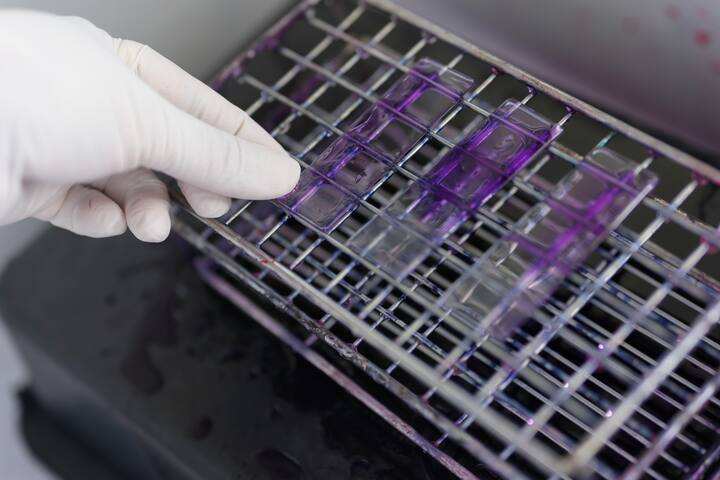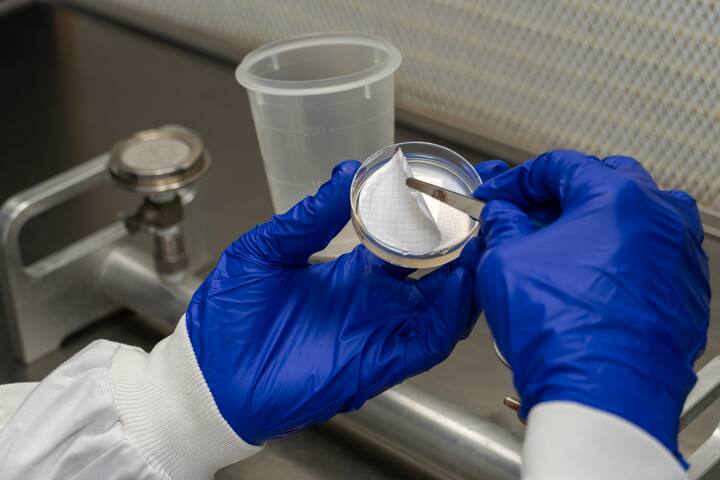
Testing precision for mycobacteria
By Fabian White RSci MRSB
A silent global health threat has been re-emerging, causing concern among experts, and it's not Covid-19. Disease caused by environmental (or “nontuberculous”) mycobacteria appears to have doubled over ten-year periods according to multiple sources, increasing in prevalence in the current day1. As many as half a million people may be infected with nontuberculous mycobacteria2 at any one time, and considering that these bacteria are ubiquitous in the environment, this is no insignificant matter. Indeed, certain populations (such as the elderly, the immunosuppressed, and especially cystic fibrosis sufferers) are significantly affected by disease from these bacteria.
The incidence of diseases associated with environmental mycobacteria is on the rise, posing a significant public health challenge. As our interactions with natural environments continue to evolve, understanding the epidemiology and risk factors for these infections becomes paramount in addressing their impact on human health.
Lurking threat
Mycobacteria, believed to have evolved around 150 million years ago3, are a genetically diverse genus with over a hundred different bacterial species, including the causative agents of tuberculosis and leprosy. They can be found in diverse environmental settings, including soil, water, and biofilms. Their unique cell wall composition, particularly the presence of mycolic acids, makes them highly resistant to disinfection and allows them to survive challenging habitats. Many mycobacteria readily grow in chlorinated water systems such as drinking water, where more virulent strains have been selected in, meaning that a greater proportion of these bacteria which we are exposed to are more capable of causing disease. As a result, there have been increased reports of hypersensitivity disorders, such as pneumonitis in otherwise healthy individuals exposed to aerosols from hot tubs and spas.4
"Mycobacteria, ancient bacteria that co-evolved with humans, continue to persist in our environment. Today, shifts in mycobacterial populations due to human activities impact the incidence of specific diseases.”
The concern about mycobacteria in environmental quality monitoring primarily revolves around the clinically-relevant species known as "non-tuberculosis mycobacteria". While these species may not spread from person to person like tuberculosis or leprosy, they can still cause a wide range of diseases, including pulmonary diseases, lymphadenitis, skin pathologies, and disseminated infections. Immunocompromised individuals, who may be more susceptible to mycobacterial infections, are at a higher risk in nosocomial settings, where environmental monitoring is crucial.
Additionally, while diseases such as tuberculosis and leprosy are often thought of as being afflictions mainly affecting lower income countries, nontuberculous mycobacterial disease is considerably relevant the world over, regardless of economic metrics such as GDP/capita.
Healthcare challenges
Healthcare settings, like hospitals and clinics, present unique challenges when it comes to mycobacteria and the risks they pose. One species of particular concern is M. chimaera, which can be difficult to diagnose because they don't show any specific symptoms. This results in late detection and treatment when more damage has been done. In some cases, these bacteria can incubate for up to 10 years before causing any symptoms, making it even harder to track down the source of the infection.
M. chimaera is often associated with heater-cooler units used in cardiothoracic surgeries. These units play a critical role in keeping the patients' blood and organs at specific temperatures during the operation. In certain heart surgeries, perfusionists may administer cardioplegia, allowing for the deliberate stopping of the heart, which is kept cold, while other parts of the body are kept warmer to prevent tissue damage. Unfortunately, many heater-cooler units use water tanks that can become contaminated with bacteria such as M. chimaera. Aerosols generated during the heating and cooling processes then come into contact with the patient and lay dormant for years, and lead to infections later on.
The gold standard
Regular testing for mycobacteria in healthcare environments is essential to identify potential risks and take appropriate preventive measures. England's Health Technical Memorandum 01-06 emphasises the need for quarterly testing for "environmental mycobacteria" in final rinse waters to ensure that these bacteria are not detected. The requirement is for non-detection in 100ml of sample when cultured onto Middlebrook 7H10 agar.5
Traditional culture-based testing, or the "Pasteurian" culture method, has been the gold standard for detecting mycobacteria, but it has its limitations. The process is slow, with an English HTM incubation requirement for 28 days. Due to the slow mitotic division rates of some strains of mycobacteria, particularly those of M. chimaera, some technical documents require culture for 8 weeks.6 It may be highly impractical to remove a heater-cooler unit from service while testing is being done over such a period.
Only a small percentage of the viable bacteria population is grown with culture testing. Treatment to kill bacteria may result in a negative culture test, but this does not guarantee the absence of viable pathogens. Some mycobacteria can enter into a protective, dormant state during treatment, rendering them non-culturable, even though they may still be alive and pose a risk.
The culture method is a simple and affordable test that can be easily interpreted by clients. If the results are positive (per 100 ml), it means that remedial action needs to be taken. However, the culture method does not give a complete picture of the bacterial population and can be slow.
A work in progress
Flow cytometry is a testing option that could be used to give a more complete picture of the bacterial population. However, there are currently no commercially available flow cytometry services that are specific to mycobacteria. While this may change in the future, it is unlikely that flow cytometry will ever be able to identify mycobacteria to the genus level. This is a further requirement specified in the English HTM, to determine the relevance and pathogenicity of any positive results.
Metagenomics is a promising technology that has seen rapid development in recent years. It can be used to study the functions of the nucleotide sequences of microorganisms in a population, such as those found in a water sample. However, the costs and technical knowledge requirements of metagenomics are very high, making it unfeasible for many applications.
An old ‘reliable’
The 40-year-old PCR-based testing offers a promising alternative. One major critique of its testing with regards to Legionella is its inability to differentiate between live and dead cells. However, when it comes to mycobacterial testing of heater-cooler units, this concern becomes less significant. Flushing the system after decontamination is essential, and in the case of these units, the small water volume they use (usually less than 5L) makes the flushing process much more practical compared to recreational water systems, which could contain thousands of litres. One issue with PCR-based identification kits of mycobacteria is that the bacteria have a thick cell wall that makes it difficult to extract the DNA. As a result, many PCR-based identification kits have limits of detection of over 10,000 colony-forming units (cfu) per test. This makes them unsuitable for environmental water testing, where the concentration of mycobacteria is typically much lower. PCR-based identification kits are generally used on isolates cultured from patients due to its much higher concentration.
Unrivalled testing precision
Soon after its inception in 1983, Latis Scientific’s small team of expert microbiologists and consultants helped establish the company as a major player in the field of environmental quality monitoring of water samples from a variety of sources. In the current day, Latis Scientific, a Normec company, and its sister laboratories have amassed considerable expertise in various fields, such as building, energy, food, healthcare, leisure and recreation, and waste. As part of their dedication to continual development in the field of healthcare (as well as many others) Normec Latis Scientific has developed a highly efficient PCR test that detects mycobacterial DNA at an equivalent or higher level than culture-based methods. Their validated DNA extraction method and optimised PCR setup ensure the accuracy of the results. At the time of publishing, this method is being assessed for accreditation by UKAS. Many PCR primers for mycobacteria in the market are not as specific, giving significant false positives and false negative results. Many such primers are based on old literature and do not account for the diversity of mycobacteria in the environment. Normec Latis Scientific has worked with a company with expertise in PCR to design highly specific PCR kits. These kits are based on datasets of genomic data from thousands of environmental mycobacteria and closely related species. The kits can be used to detect a wide range of mycobacteria, including Mycobacterium abscessus, the Mycobacterium avium complex, and M. chimaera.
Onward and upward
Looking to the future, new product developments may mean that cardioplegia will move to using new non-aerosol producing units, potentially reducing the risk of M. chimaera infections. However, replacing existing machines and implementing new procedures may take time and resources. As mycobacteria continue to evolve and with the emergence of new medical procedures, vigilance and effective monitoring remain essential to ensure patient safety in healthcare settings. In the meantime, where possible, it may be a good idea to keep such units away from patients, testing them quarterly or more frequently as required. Mycobacteria are a diverse group of species with a fascinating history. Their presence in various environmental settings, including healthcare facilities, calls for rigorous environmental quality monitoring. By staying at the forefront of scientific developments, we can ensure a safer healthcare environment and protect patients from potential mycobacterial infections.
References:
Ratnatunga CN, Lutzky VP, Kupz A, Doolan DL, Reid DW, Field M, Bell SC, Thomson RM and Miles JJ (2020) The Rise of Non-Tuberculosis Mycobacterial Lung Disease. Front. Immunol. 11:303. doi: 10.3389/fimmu.2020.00303
UK AaL. Non-tuberculous mycobacterial infection (NTM) London, UK2022 [Available from: https://www.asthmaandlung.org.uk/conditions/non-tuberculous-mycobacterial-infection-ntm.]
Hayman J. Mycobacterium ulcerans: an infection from Jurassic time? Lancet. 1984;2(8410):1015-6.
Hartman TE, Jensen E, Tazelaar HD, Hanak V, Ryu JH. CT findings of granulomatous pneumonitis secondary to Mycobacterium avium-intracellulare inhalation: "hot tub lung". AJR Am J Roentgenol. 2007;188(4):1050-3.
England N. Health Technical Memorandum 01-06: Decontamination of flexible endoscopes. Part E: Testing methods. London, UK: Crown; 2016.
ECDC. EU protocol for case detection, laboratory diagnosis and environmental testing of Mycobacterium chimaera infections potentially associated with heater-cooler units: case definition and environmental testing methodology. Stockholm: ECDC; 2015.
Author’s bio: Fabian White started his journey with Latis Scientific (now known as Normec Latis Scientific) in 2016 where he now works as the Technical Manager for the laboratories in Crayford, Kent, as well as the newly-built microbiology site in Consett, County Durham. In his role he works closely with the sales, marketing, quality and laboratory teams, improving methods, developing new capabilities and working on various projects. Fabian is passionate about environmental bacteriology and is an active member of the Royal Society of Biology.
Reliable mycobacteria testing for healthcare and critical equipment
Prevent outbreaks and protect vulnerable patients with fast, UKAS-accredited mycobacteria testing. From water systems to heater-cooler units, our qPCR and culture methods provide rapid and reliable detection of harmful species like Mycobacterium chimaera, M. abscessus, and M. avium.
Curious how our services help healthcare providers meet guidelines and keep equipment safe for use?

More about Normec Latis Scientific

Normec Latis Scientific
London United Kingdom